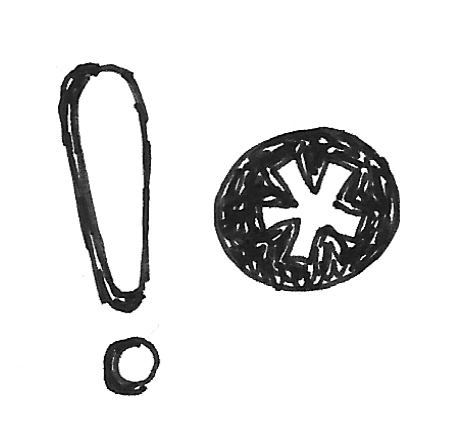In 2017, we will radically rethink our designs, and what they say, what they assume, and how they might better serve our audiences.
Let’s start with the headline. For example: Could an initial headline reflect visually that the story is evolving and contains incomplete information? Maybe a first report headline could look like this, with an empty outline?

And then change in appearance to something like this, semi-filled, when we learn more information?

And then change a third time when the story is complete?

 In other words, how can we encode as much useful information as possible in a headline? Colors, fonts, shading, size, position, pictures, interactivity, history, metadata — basically all the design elements of information encoding across multiple dimensions. Which of those are most helpful to enhancing the headline? How can we test them?
In other words, how can we encode as much useful information as possible in a headline? Colors, fonts, shading, size, position, pictures, interactivity, history, metadata — basically all the design elements of information encoding across multiple dimensions. Which of those are most helpful to enhancing the headline? How can we test them?
For example, could we think of a headline as something that one can hover over, and immediately see source material? Or how many times the headline has changed? Or how other publications have written the same headline? (How does that help readers? How could that help publications?)
Let’s go broader. Why are headlines text? Could they be something else? What is the most important element at the top of a page? Is it five to fourteen words or is it something else entirely?

Could we have multiple headlines for the same piece? Maybe write one that reports verbatim what happened. Then one that interprets, particularly if what happens verbatim isn’t actually true. Then maybe one that sees what happens from a different point of view. Then one that uses a quote. Then one that uses numbers. Publish all of them alongside a story. (Other interesting existing examples: L.A. Times sharelines, WaPo’s Bandito, Bloomberg’s perpetual re-headlining and headline A/B testing, Optimizely and ChartBeat‘s headline A/B testing solutions, Naytev‘s social media multiple headline testing solution.) Are more dynamic, detailed, and numerous headlines on single articles effective ways for news organizations to distinguish themselves from generic fake news sites?
Could a headline be a comment? Could it be a visualization? What material does a reader need at the top of a page? Is it text? A push notification? Let’s pause there for a second. With newly designed headlines, translations to a push notification could get murky. Things like mouse-hover functionality won’t be accessible by mobile users.
We then have a constrained creativity problem, where constraints are embedded in various operating systems. It also suggests that headline writing may now span multiple jobs. Or maybe those all fall under one job, and it just means “headline writing” is now a bigger part of an editor’s job. And the skill set required is different.
Back to constraints within platforms limiting our creativity. Do we only think of mainly-text-based solutions because of the current nature of the platforms we share on? What if that changes? How could that change? A lot of current restrictions around headlines come from social and search restrictions and it would be interesting to think about that impact and how publications might bypass them with headline-like constructs (like Mic’s multimedia notifications or BuzzFeed’s emoji notifications.) They’re take the headline space and reworking it using images. What could we use besides images? In addition to images?

Let’s think about this in terms of ads. Look at Facebook Ads. They localize headlines. Should news headlines be localized? What does that feel like?
What other kinds of information could be contained in the space that we currently call “headline”?
How might this help readers?
Now let’s repeat this experiment for first paragraphs, bylines, right rails, left rails, comment sections, landing pages, mastheads, verticals, investigative stories, push notifications, style section stories, homepages, metadata, what you measure, how you measure, and every other bit on your site. 2017 means rethinking every aspect of our designs: what they say, what they assume, and how they might better serve our audiences.
Thank you to Matt Crespi and Aram Zucker-Scharff for thinking through some of these ideas with me.
Melody Joy Kramer leads audience growth and development for the Wikimedia Foundation. Lisa Romero, whose work appears throughout this piece, is an illustrator based in Santa Fe, New Mexico.
Pablo Boczkowski Fake news and the future of journalism
Liz Danzico The triumph of the small
Julia Beizer Building a coherent core identity
Lam Thuy Vo The primary source in the age of mechanical multiplication
Amy O'Leary Not just covering communities, reaching them
Keren Goldshlager Defining a focus, and then saying no
Helen Havlak Chasing mobile search results
Sydette Harry Facing journalism’s history
Dan Colarusso Let’s make live video we can love
Millie Tran International expansion without colonial overtones
Megan H. Chan Cultural reporting goes mainstream
Jonathan Hunt Measurement companies get with the times
Valérie Bélair-Gagnon Truthiness in private spaces
Claire Wardle Verification takes center stage
Burt Herman Local news gets interesting
Aja Bogdanoff Comments start pulling their weight
Robert Hernandez History will exclude you, again
Amy Webb Journalism as a service
Hillary Frey Forests need to burn to regrow
Mira Lowe News literacy, bias, and “Hamilton”
Erin Pettigrew A year of reflection in tech
Melody Kramer Radically rethinking design
Emi Kolawole From empathy to community
Matt Karolian AI improves publishing
Ståle Grut The battle for high-quality VR
Mario García Virtual reality on mobile leaps forward
Elizabeth Jensen Trust depends on the details
Asma Khalid The year of the newsy podcast
Caitlin Thompson High touch, high value
Eric Nuzum Podcasting stratifies into hard layers
Richard Tofel The country doesn’t trust us — but they do believe us
Jim Friedlich A banner year for venture philanthropy
Mathew Ingram The Faustian Facebook dance continues
Cindy Royal Preparing the digital educator-scholar hybrid
Carrie Brown We won’t do enough
Zizi Papacharissi Distracted journalism looks in the mirror
Katie Zhu The year of minority media
Jeremy Barr A terrible year for Tiers B through D
Juliette De Maeyer and Dominique Trudel A rebirth of populist journalism
Kawandeep Virdee Moving deeper than the machine of clicks
Ole Reißmann Un-faking the news
Juan Luis Sánchez Your predictions are our present
David Chavern Fake news gets solved
Nushin Rashidian A rise in high-price, high-value subscriptions
Priya Ganapati Mobile websites are ready for reinvention
Dannagal G. Young The return of the gatekeepers
Nicholas Quah Podcasting’s coming class war
Reyhan Harmanci Bear witness — but then what?
Sam Ford The year we talk about our awful metrics
Corey Ford The year of the rebelpreneur
Andrew Losowsky Building our own communities
Peter Sterne A dangerous anti-press mix
Sarah Marshall Focusing on the why of the click
Alexis Lloyd Public trust for private realities
Scott Dodd Nonprofits team up for impact
Andy Rossback The year of the user
Vivian Schiller Tested like never before
Bill Adair The year of the fact-checking bot
Tressie McMillan Cottom A path through the media’s coming legitimacy crisis
Rubina Madan Fillion Snapchat grows up
Swati Sharma Failing diversity is failing journalism
Ashley C. Woods Local journalism will fight a new fight
Andrew Ramsammy Rise of the rebel journalist
Amie Ferris-Rotman Вслед за Россией
Margarita Noriega From pinning tweets to tweeting pins
Guy Raz Inspiration and hope will matter more than ever
Tim Griggs The year we stop taking sides
Mary Meehan Feeling blue in a red state
David Weigel A test for online speech
Ariane Bernard Better data about your users
S.P. Sullivan Baking transparency into our routines
Geetika Rudra Journalism is community
Lee Glendinning A call for great editing
Liz McMillen The year of deep insights
Emily Goligoski Incorporating audience feedback at scale
Andrea Silenzi Podcasts dive into breaking news analysis
Tanya Cordrey The resurgence of reach
Almar Latour Thanks, #fakenews
Taylor Lorenz “Selfie journalism” becomes a thing
Annemarie Dooling UGC as a path out of the bubble
Steve Henn The next revolution is voice
Rasmus Kleis Nielsen News after advertising may look like news before advertising
Christopher Meighan Unlocking a deeper mobile experience
Tracie Powell Building reader relationships
Dhiya Kuriakose The year of digital detoxing
Alice Antheaume A new test for French media
Michael Oreskes Reversing the erosion of democracy
Umbreen Bhatti A sense of journalists’ humanity
Dan Gillmor Fix the demand side of news too
Erin Millar The bottom falls out of Canadian media
Cory Haik Navigating power in Trump’s America
Joanne Lipman The year of the drone, really
Doris Truong Connecting with diverse perspectives
Javaun Moradi What can we own?
Sara M. Watson There is no neutral interface
Ernst-Jan Pfauth Earn trust by working for (and with) readers
David Skok What lies beyond paywalls
Rebekah Monson Journalism is community-as-a-service
Tim Herrera The safe space of service journalism
Michael Kuntz Trust is the new click
Anita Zielina The sales funnel reaches (and changes) the newsroom
Mike Ragsdale A smarter information diet
Libby Bawcombe Kids board the podcast train
Maria Bustillos “It’s true — I saw it on Facebook”
Rachel Schallom Stop flying over the flyover states
Rachel Sklar Women are going to get loud
Adam Thomas The coming collaboration across Europe
Nathalie Malinarich Making it easy
Ryan McCarthy Platforms grow up or grow more toxic
M. Scott Havens Quality advertising to pair with quality content
Alberto Cairo Communicating uncertainty to our readers
Ray Soto VR moves from experiments to immersion
Carla Zanoni Prioritizing emotional health
Laura Walker Authentic voices, not fake news
Sue Schardt Objectivity, fairness, balance, and love
Olivia Ma The year collaboration beats competition
Andrew Haeg The year of listening
Jonathan Stray A boom in responsible conservative media
P. Kim Bui The year journalism teaches again
Ken Schwencke Disaggregation and collection
Kathleen Kingsbury Print as a premium offering
Gabriel Snyder The aberration of 20th-century journalism
Francesco Marconi The year of augmented writing
Matt Waite The people running the media are the problem
AX Mina 2017 is for the attention innovators
Samantha Barry Messaging apps go mainstream
Renée Kaplan Pure reach has reached its limit
Moreno Cruz Osório The year of transparency in Brazilian journalism
Jon Slade Trusted news, at a premium
Mandy Velez The audience is the source and the story
Molly de Aguiar Philanthropists galvanize around news